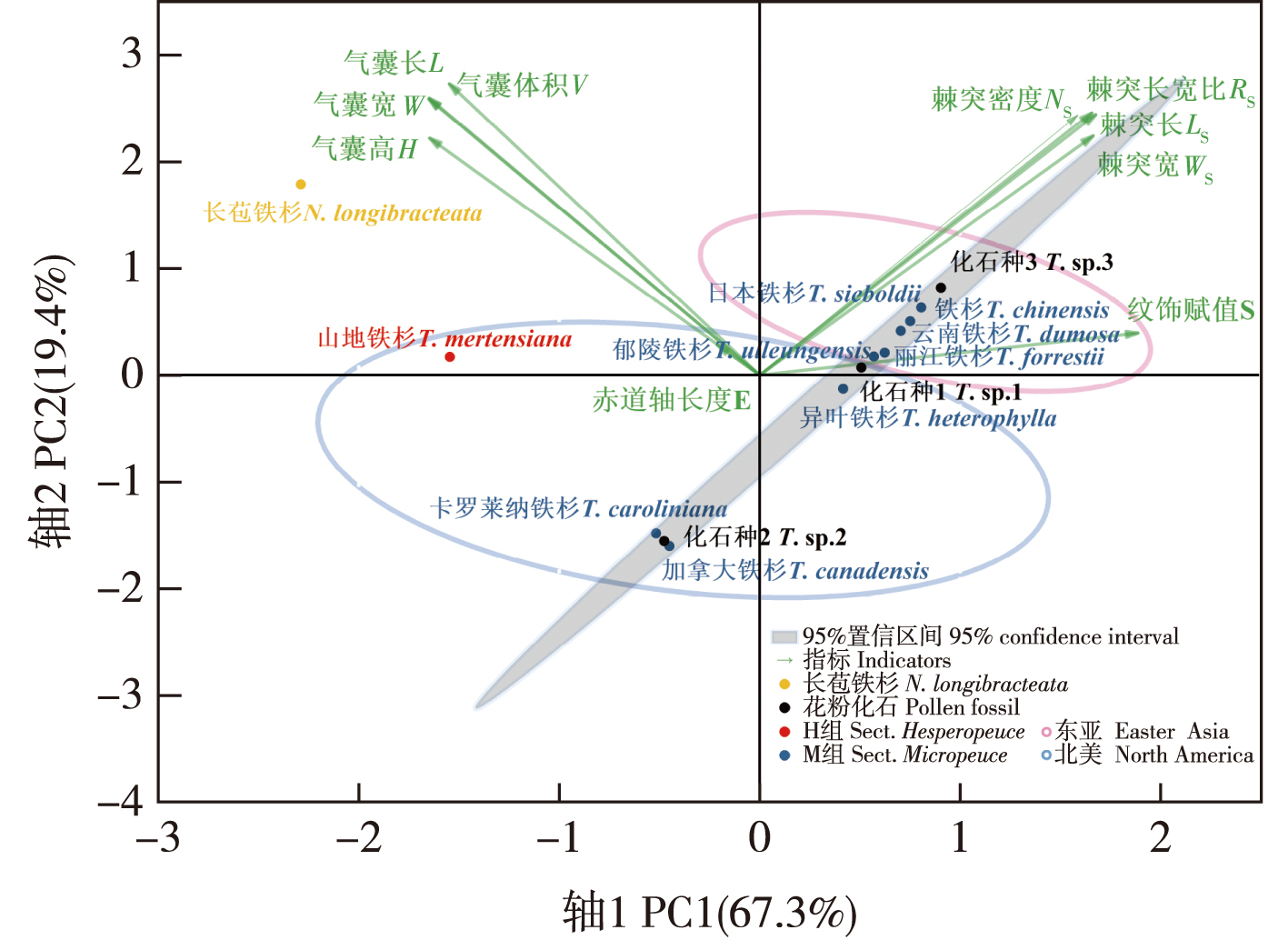 PDF(5207 KB)
PDF(5207 KB)


 PDF(5207 KB)
PDF(5207 KB)
 PDF(5207 KB)
PDF(5207 KB)
铁杉属花粉形态及其聚类分析研究
Phylogenetic relationship and evolutionary patterns of Tsuga pollen morphology: a cluster analysis-based study
【目的】对铁杉属(Tsuga)现存所有10种植物花粉形态特征进行观察比较,结合花粉化石分析铁杉属系统发育关系及花粉形态的演化过程。【方法】通过扫描电子显微镜(SEM)观察铁杉属的花粉形态特征,并利用7个定量指标和1个定性指标进行系统聚类分析(HCA)。【结果】铁杉属花粉为N1P3C1型花粉,远极面具薄壁区,赤道轴长度为21.20~58.00 μm,多无气囊,稀有气囊;花粉粒表面多疣状,稀微疣状,表面有棘突或无。系统聚类分析显示铁杉属花粉可以分类为3类:①有气囊,无棘突类:山地铁杉(T. mertensiana)与长苞铁杉(Nothotsuga longibracteata);②无气囊,无棘突类:卡罗莱纳铁杉(T. caroliniana)、加拿大铁杉(T. canadensis)与化石种2 (T. sp.2);③无气囊,有棘突类: 异叶铁杉(T. heterophylla)、郁林铁杉(T. ulleungensis)、米铁杉(T. diversifolia)、丽江铁杉(T. forrestii)、日本铁杉(T. sieboldii)、云南铁杉(T. dumosa)、铁杉(T. chinensis)、化石种1(T. sp.1 )和化石种3 (T. sp.3 )。【结论】铁杉属花粉是从有气囊向无气囊,无棘突向有棘突演化的,且花粉特征与分布地有密切关系,同一地区分布的花粉形态相似。基于花粉形态的聚类分析结果与分子系统发育树大体符合,可以通过花粉形态对铁杉属植物及化石进行物种鉴定,并为其系统发育研究提供参考。
【Objective】To analyze the phylogenetic relationships and evolutional patterns of pollen morphology in Tsuga, we observed and compared the pollen characteristics of all 10 extant species of Tsuga along with pollen fossils.【Method】Pollen morphology was examined using scanning electron microscopy (SEM), and hierarchical cluster analysis (HCA) was conducted using seven quantitative indicators and one qualitative indicator.【Result】Tsuga pollens typically exhibits characteristics of the N1P3C1 type, with a leptoma on the distal face. The equatorial length ranges from 21.20 to 58.00 μm, predominantly lacking sacci but occasionally with echinae saccate forms. The pollen surface is typically warty or sparsely micro-warty, with spines or without. According to the hierarchical cluster analysis, Tsuga could be divided into three categories: ①saccate but lacking echinae type: T. mertensiana and Nothotsuga longibracteata; ②lacking sacci and echinae type: T. caroliniana, T. canadensis and pollen fossil T. sp.2; ③lacking sacci but echinate type: T. heterophylla, T. ulleungensis, T. diversifolia, T. forrestii, T. sieboldii, T. dumosa, T. chinensis and pollen fossil T. sp.1, T. sp.3.【Conclusion】Pollen morphology in Tsuga has evolved from saccate to non-saccate forms, and from lacking spines to possessing spines. These pollen characteristics are closely related to geographic distribution, indicating similarity among pollen from the same regions. The clustering analysis based on pollen morphology largely aligns with molecular phylogenetic trees, offering a method to distinguish extant species and fossils of Tsuga and providing valuable insights for phylogenetic studies of Tsuga.

Tsuga / pollen morphology / scanning electron microscopy(SEM) / cluster analysis
| [1] |
李楠. 论松科植物的地理分布、起源和扩散[J]. 植物分类学报, 1995, 33(2):105-130.
|
| [2] |
|
| [3] |
|
| [4] |
|
| [5] |
|
| [6] |
|
| [7] |
|
| [8] |
|
| [9] |
|
| [10] |
郑万钧. 贵州铁杉之一新种[J]. 中国科学社生物研究所论文集:植物辑, 1932, 7(1):1-2.
|
| [11] |
|
| [12] |
|
| [13] |
|
| [14] |
|
| [15] |
|
| [16] |
|
| [17] |
|
| [18] |
|
| [19] |
|
| [20] |
|
| [21] |
|
| [22] |
|
| [23] |
王伏雄, 钱南芬, 张玉龙, 等. 中国植物花粉形态[M]. 2版. 北京: 科学出版社, 1995:1-10, 197-202.
|
| [24] |
王开发, 王宪曾. 孢粉学概论[M]. 北京: 北京大学出版社, 1983:23,32-34.
|
| [25] |
|
| [26] |
薛美玲, 郝秀东, 黄旭光, 等. 20个朱槿品种花粉形态扫描电镜观察分析[J]. 分子植物育种, 2023, 1-17.
|
| [27] |
张淑钧, 杨欣欣, 罗建. 西藏色季拉山区风毛菊属植物花粉形态特征及其分类学意义[J]. 植物研究, 2023, 43(5):741-755.
|
| [28] |
曹婧, 戴忠良, 徐迎春, 等. 睡莲属植物花粉形态研究[J]. 西北植物学报, 2023, 43(7):1227-1235.
|
| [29] |
孙爱芝, 马玉贞, 黄昌庆, 等. 松科花粉鉴定要点及其生态环境特征研究[J]. 兰州大学学报, 2006, 42(5):18-21.
|
| [30] |
张金谈. 中国松科花粉形态研究[J]. 植物研究, 1989, 9(3):87-95,97-98.
|
| [31] |
王伏雄, 钱南芬, 张金谈. 花粉形态的研究 Ⅱ.松科及落羽杉科的花粉[J]. 植物学报, 1955, 4(1):47-62.
|
| [32] |
|
| [33] |
|
| [34] |
瑞典埃尔特曼(G.ERDFMAN). 孢粉学手册[M].中国科学院植物研究所古生物研究室孢粉组, 译. 北京: 科学出版社, 1978.
|
| [35] |
徐克学. 数量分类学[M]. 北京: 科学出版社, 1994:27-28,47-50.
|
| [36] |
邹惠渝, 张凤春. 长苞铁杉和铁杉属数量分类的研究[J]. 南京林业大学学报(自然科学版), 1996, 20(1):43-47.
|
| [37] |
|
| [38] |
|
| [39] |
|
| [40] |
胡先骕. 种子植物分类学讲义[M]. 上海: 中华书局, 1951.
|
| [41] |
|
| [42] |
李林初. 若干铁杉属植物核型的比较研究[J]. 广西植物, 1988, 8(4):324-328.
|
| [43] |
李林初. 长苞铁杉的核型分析及其分类学意义[J]. 云南植物研究, 1991, 13(3):309-313.
|
| [44] |
李林初. 松科的核型和系统发育研究[J]. 植物分类学报, 1995, 33(5):417-432.
|
| [45] |
李林初, 杨凤辉, 蔡星星. 大果铁杉的核型分析及铁杉属的细胞分类学研究[J]. 复旦学报(自然科学版), 2000, 39(4):432-435.
|
| [46] |
喻诚鸿. 铁油杉的木材结构和它在分类上的位置[J]. 植物学报, 1956, 5(2):243-248.
|
| [47] |
周崟, 姜笑梅. 木材构造特征在裸子植物系统学中的意义[J]. 植物分类学报, 1992, 30(5):405-414.
|
| [48] |
肖良, 王宏宇, 国丽妍, 等. 铁杉属的起源、扩散与传播:基于化石证据[J]. 地球环境学报, 2023, 14(1):9-26.
|
西北农林科技大学重点实验室的张国云老师、园艺学院陈蕊红老师提供扫描电镜,兰州大学孙柏年教授和韩磊博士提供化石样本,中科院植物所的孔宏智研究员和于宁宁博士、华南植物园的余恩平同学、云南大学的周新茂副教授及蒋璐遥同学、南京林业大学的袁禹婷同学、美国密苏里植物园的张丽兵研究员和韩国国家植物园Chang Kae Sun教授协助样品采集。
/
| 〈 |
|
〉 |